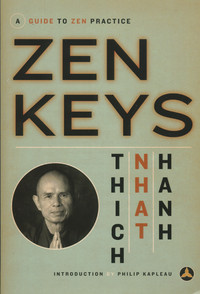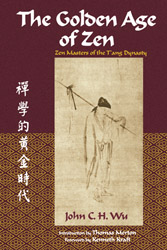|
Zen Keys
By Thich Nhat Hanh
Translated from the French by Albert and Jean Low, with an Introduction by Philip Kapleau.
New York: Image Books Doubleday, 1995. Pp. 199. 
The Golden Age of Zen.
by John C. Wu, with an Introduction by Thomas Merton.
New York: Image Books Doubleday, 1996. Pp. viii + 228. 
reviewed by Frank J Hoffman, University of Pennsylvania
© University of Hawai'i Press
Philosophy East and West. Honolulu: Jan 1998. Vol. 48, Iss. 1; pg. 165
Zen Keys and The Golden Age of Zen are both welcome reissues of works that have already made their mark. Thich Nhat Hanh's Zen Keys was originally published in France as Clefs pour le Zen (1973), and John Wu's The Golden Age of Zen was published in Taiwan in an English edition, under this title (1975). Thomas Merton wrote the Introduction to Wu's book, and Nhat Hahn and Wu alike seem to resonate with Merton.
  Thich Nhat Hanh's Zen Keys opens with an Introduction by Philip Kapleau. This work is accessible to the nonspecialist but of interest to scholars as well. It makes Buddhist thought come alive for a contemporary readership. For instance, paticcasamuppada (causality) is read as "interbeing" when the author writes: "Genesis in Buddhism is called interbeing. The birth, growth, and decline of things depends upon multiple causes and conditions and not just a single one. The presence of one thing (dharma) implies the presence of all other things. The enlightened man or woman sees each thing not as a separate entity but as a complete manifestation of reality." True happiness does not consist in consumption based on oppression, but in "a life enlightened by the insight into interbeing" and deep responsibility. Throughout, Nhat Hanh demonstrates an uncanny ability to render Buddhist terms in English in a fresh and insightful way. For example, Zen patriarchs are restyled as "ancestral teachers," a locution arguably both more up-to-date and informative of Buddhist meaning. Nhat Hanh is quick to assert that Western Zen cannot be merely imitative, but "must be Western in its form." Thich Nhat Hanh's Zen Keys opens with an Introduction by Philip Kapleau. This work is accessible to the nonspecialist but of interest to scholars as well. It makes Buddhist thought come alive for a contemporary readership. For instance, paticcasamuppada (causality) is read as "interbeing" when the author writes: "Genesis in Buddhism is called interbeing. The birth, growth, and decline of things depends upon multiple causes and conditions and not just a single one. The presence of one thing (dharma) implies the presence of all other things. The enlightened man or woman sees each thing not as a separate entity but as a complete manifestation of reality." True happiness does not consist in consumption based on oppression, but in "a life enlightened by the insight into interbeing" and deep responsibility. Throughout, Nhat Hanh demonstrates an uncanny ability to render Buddhist terms in English in a fresh and insightful way. For example, Zen patriarchs are restyled as "ancestral teachers," a locution arguably both more up-to-date and informative of Buddhist meaning. Nhat Hanh is quick to assert that Western Zen cannot be merely imitative, but "must be Western in its form."
Philosophers trained in the West may mourn the lack of detailed discussions of philosophical distinctions and problems, but evidently wordy warfare is not Nhat Hahn's purpose. "There is not the drinker of the tea and the tea being enjoyed, because there is no distinction between subject and object in the real experience" says Nhat Hahn, expounding the traditional Zen "no distinction between subject and object" perspective. The emphasis on wu nien ("nonconceptual thought") without detailed analysis, however, is philosophically problematic. On the positive side, the Zen emphasis on respect for all living beings accompanied by deep gratitude and everyday mindfulness comes through clearly in Nhat Hahn's writing.
Nhat Hahn maintains that whereas the East has modestly tried to learn from the West, the converse is not true. Westerners "are satisfied with their methodology and their principles, and they remain attached to criteria and values of their own civilization while desiring to know the East. They are afraid of losing their identity and this is the principle cause of their difficulties." In this, Thich Nhat Hanh is implicitly critical of many of the forms that "comparative philosophy" takes in the West. He seems to see that an understanding of "Orientalism" should inform the comparative enterprise. But what specific role philosophy would rightly have is somewhat opaque here, for on his view, Zen sees reality itself. Enough said.
Thus, in his own Zen way, Nhat Hanh is harbinger of the end of philosophy. At best, his work reveals lucid depth without pretension or obfuscation in his renderings of key terms. At worst, his enchanting prose conceals philosophical problems in which philosophers have a legitimate interest. The work usefully concludes with forty-three kung-ans with comments and verses of Tran Thai Tong (1218-1277).
The Golden Age of Zen, by John Wu (Wu Ching-hsiung), begins with an Introduction by Thomas Merton. Wu kindly asserts that the book is but a long footnote to Merton's introduction. This book covers the Zen Buddhism of the T'ang dynasty (618-906 C.E.). Wu recognized that comparing Christianity to Zen is as impossible as comparing mathematics to tennis, thinks Merton, who also feels that Zen involves grasping certainty in the sense of "an authentic metaphysical intuition, which is also existential and empirical." The meaning and possibility of this complex claim go unanalyzed.
Wu gives detailed characterizations of the "five houses of Ch'an" and a genealogical chart. The Houses of Lin-chi and Yun-men are "steeped and sharp-edged," the House of Ts'ao-tung "close-knit and resourceful," that of Fa-yen "speculative and broad," whereas the House of Kuei-yang has "a greater depth than the others." One way in which the depth of the House emerges is in its distinction between Tathagata Ch'an and Patriarch Ch'an. The former is a matter of faith, meditation, and asceticism, whereas the latter is spontaneous articulation and direct insight into one's true self. chart. The Houses of Lin-chi and Yun-men are "steeped and sharp-edged," the House of Ts'ao-tung "close-knit and resourceful," that of Fa-yen "speculative and broad," whereas the House of Kuei-yang has "a greater depth than the others." One way in which the depth of the House emerges is in its distinction between Tathagata Ch'an and Patriarch Ch'an. The former is a matter of faith, meditation, and asceticism, whereas the latter is spontaneous articulation and direct insight into one's true self.
Wu provides a useful background to the lives of Hui-neng and other major figures. For example, Wu contextualizes the famous verses of Huineng and Shen-shiu, in contrast to others who have merely quoted the verses. A sympathetic understanding of both Hui-neng and Shen-shiu emerges in contrast to treatments of Shen-shiu as merely a foil to Huineng. Wu's discussions are detailed, as when he interprets pu li wen tze (often rendered "no dependence on words and letters") to mean "no setting up of words and letters." We utilize, but do not idolize, words and letters. While never losing sight of the fact that intuition and tuition differ markedly, Wu does not allow the reader to fall into a stereotype of Zen as anti-intellectual simpliciter. Wu emphasizes the connections between Zen and other forms of thought. Hui-neng, for example, brought out the universal aspect of Ch'an so well that even Confucianists could find points of agreement. Ma-tsu Tao-i's skill and resourcefulness as a teacher empowering students to self-discovery is illustrated in several anecdotes. In one, he tweaks the nose of Pai-chang and the latter attains enlightenment. Wu is not content to list anecdotes, but provides a wealth of background details facilitating historical understanding.
One oddity, however, is that an anecdote about D. T. Suzuki saying "Living is dying" is repeated almost verbatim in two places very close together (pp. 192 and 217).
Overall, the quality of Wu's thought is evident in numerous ways. Wu's work shows his ability to think through some superficial understandings of key terms. Koans, for example, are not "puzzles," for that would make them purely intellectual objects. In the intense agony of struggling with a koan the inner eye opens.
Both of these volumes are very much worth acquiring for the first, or even the second, time.
|
Search thezensite
Updates to thezensite
Zen Book Reviews
Miscellaneous & Reading Lists
Book Sources
Zen Links
Journals and Acedemic Sites of Interest
Miscellaneous
Non-Zen Topics
Essays of Interest
Interesting Sites
Miscellaneous
humour
art
If you wish, you may make a small donation to help this site defray overhead costs.
Thank you.
|
